story and photos by Kayte Deioma
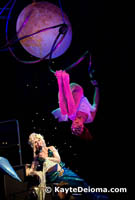 In 1976 – six years before the first Cirque du Soleil production – Circus Roncalli was born. It was the brain child of Bernhard Paul, an Austrian who left his job as Art Director at an international advertising agency to follow his dream of starting a circus. His new spectacle was dense with the
In 1976 – six years before the first Cirque du Soleil production – Circus Roncalli was born. It was the brain child of Bernhard Paul, an Austrian who left his job as Art Director at an international advertising agency to follow his dream of starting a circus. His new spectacle was dense with the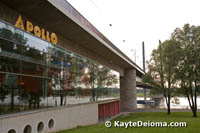 world’s finest physical circus acts. For over 30 years Circus Roncalli has toured Europe, becoming a much-loved tradition.
world’s finest physical circus acts. For over 30 years Circus Roncalli has toured Europe, becoming a much-loved tradition.
The original Apollo Theater on Dusseldorf’s Graf Adolf Platz provided variety shows including singers, dancers, comedians, acrobats and later film components from 1899 into the 1950s. It was torn down in the 1960s to make way for an office tower.The New Apollo is a glass-enclosed dinner theater tucked under the Rheinknie Bridge, overlooking the Rhine River.
In1997, Paul combined his successful Roncalli circus acts with Dusseldorf’s long history of vaudeville-style variety entertainment to open Roncalli’s Apollo Varieté in the New Apollo Theater. Once again, acts from around the world come to astound and amaze visitors with their feats of human strength, agility and dexterity, as well as musical and vocal prowess.
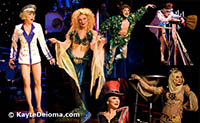 The shows change every couple months, with new performers taking the stage. The spectacle that I attended was called Mondkuss (Moon Kiss). Our MC was the multi-talented Chris, a quick-change artist in drag, who converted from little old lady to sequined mermaid and from singer to tap dancer to trapeze
The shows change every couple months, with new performers taking the stage. The spectacle that I attended was called Mondkuss (Moon Kiss). Our MC was the multi-talented Chris, a quick-change artist in drag, who converted from little old lady to sequined mermaid and from singer to tap dancer to trapeze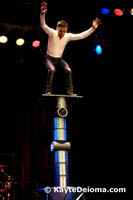 artist in the blink of an eye.
artist in the blink of an eye.
Chris was accompanied on stage by a tightrope walker, juggler, trapeze artist, hand-stand acrobat, vertical rope performer, and a balancing act. 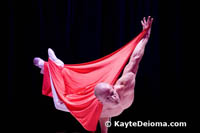 Soprano Elizabeth Haumann added vocal contrast, singing sometimes solo and also in duets with Chris. Songs were in both German and English, with at least one other language thrown in for good measure.
Soprano Elizabeth Haumann added vocal contrast, singing sometimes solo and also in duets with Chris. Songs were in both German and English, with at least one other language thrown in for good measure.
In June and July 2007, Circus-Theater BINGO will take the stage with their production of Cult, including eighteen performers from the Ukraine and Moldavia. Among the acrobatics, it will contain more dance elements, pantomime and the multi-genre music quartet, Bryats Band.
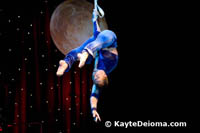 The amount of any language used in a production varies by show, but there’s always plenty to enjoy for those who don’t speak German. Most shows are family friendly, but some include adult content, so check with the theater before booking tickets for children.
The amount of any language used in a production varies by show, but there’s always plenty to enjoy for those who don’t speak German. Most shows are family friendly, but some include adult content, so check with the theater before booking tickets for children.
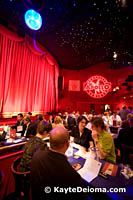 Dinner is available either upstairs before the show in the glass-enclosed dining room overlooking the Rhine, or in the theater itself before and during the show. Only beverages are available in the balcony seats. Show tickets can be purchased without dinner. You can also dine
Dinner is available either upstairs before the show in the glass-enclosed dining room overlooking the Rhine, or in the theater itself before and during the show. Only beverages are available in the balcony seats. Show tickets can be purchased without dinner. You can also dine 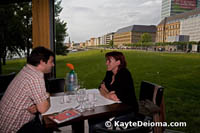 in the upstairs restaurant without seeing the show. Smoking is allowed in the theater except during the smoke-free Sunday matinee, but I didn’t notice is being overly smoky.
in the upstairs restaurant without seeing the show. Smoking is allowed in the theater except during the smoke-free Sunday matinee, but I didn’t notice is being overly smoky.
Occasionally, special one or two-night productions will interrupt the run of a longer show. For those planning a corporate meeting or conference in Dusseldorf, Roncalli’s Apollo Varieté also provides an opportunity to work your program or product into a special performance by their artists.
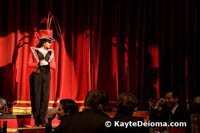 Roncalli’s Apollo Varieté
Roncalli’s Apollo Varieté
Apollo Platz 1
40213 Dusseldorf
49 (0) 211-828-9090
www.apollo-variete.com
info@apollo-variete.com

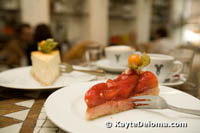 Like afternoon tea in England, Kaffee und Kuchen or coffee and cake is a time-honored ritual in Germany. Rather than serving dessert after a meal as we do in the U.S., sweets get their own dedicated meal mid-afternoon. Restaurants may hold strictly to their Coffee Table hours of 2:30 or 3 pm until 5, then re-open for dinner at 6:30 or 7 pm, but cafes are more flexible, and will serve you coffee and cake until they run out of cake.
Like afternoon tea in England, Kaffee und Kuchen or coffee and cake is a time-honored ritual in Germany. Rather than serving dessert after a meal as we do in the U.S., sweets get their own dedicated meal mid-afternoon. Restaurants may hold strictly to their Coffee Table hours of 2:30 or 3 pm until 5, then re-open for dinner at 6:30 or 7 pm, but cafes are more flexible, and will serve you coffee and cake until they run out of cake. As for cake, the Germans go all out with elegant layer cakes, streusel cakes with different kinds of fruit such as cherry or plum, apple cakes similar to a deep dish pie, fancy fruit tortes and gooey cream cakes. Then there are the cheese cakes, flat or tall, made with different kinds of cheese depending on the baker’s preferences, and sometimes combined with other ingredients like fruit or chocolate.
As for cake, the Germans go all out with elegant layer cakes, streusel cakes with different kinds of fruit such as cherry or plum, apple cakes similar to a deep dish pie, fancy fruit tortes and gooey cream cakes. Then there are the cheese cakes, flat or tall, made with different kinds of cheese depending on the baker’s preferences, and sometimes combined with other ingredients like fruit or chocolate.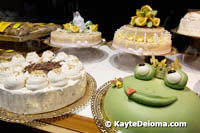 Café Heinemann (
Café Heinemann ( 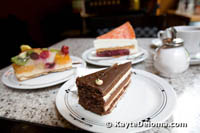 At the south end of Königsallee, signs will direct you around the corner to Bahnstrasse 16. If the tantalizing cake selection in the window doesn’t draw you in, the fanciful chocolates will. In May, the selection included chocolate May beetles filled with champagne truffle and white chocolate asparagus spears in honor of asparagus season. Although the café/bakery is in the Viennese tradition, cakes range from the traditional Mozart torte with layers of chocolate, hazelnut cream and marzipan to the original Hawaii cake with at least seven kinds of fruit. For ease of ordering from the dozen or so varieties available, you select your cake from the display case up front before you sit down and order coffee.
At the south end of Königsallee, signs will direct you around the corner to Bahnstrasse 16. If the tantalizing cake selection in the window doesn’t draw you in, the fanciful chocolates will. In May, the selection included chocolate May beetles filled with champagne truffle and white chocolate asparagus spears in honor of asparagus season. Although the café/bakery is in the Viennese tradition, cakes range from the traditional Mozart torte with layers of chocolate, hazelnut cream and marzipan to the original Hawaii cake with at least seven kinds of fruit. For ease of ordering from the dozen or so varieties available, you select your cake from the display case up front before you sit down and order coffee.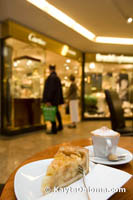 If you’re inside the maze of shopping passages along the east side of Königsallee, make your way to the top of the rotunda in the Kö Galerie to the Rondo Café & Bar. The tables all have a view down into the many levels of exclusive shops below, and if you can’t afford the Cartier shop next to the café, coffee and cake is no more expensive than anywhere else in town. The cakes are made by the same baker who supplies the café at the Benrath Palace. You won’t find the 25 varieties available at Benrath, but the half a dozen on offer each day are sure to be excellent. I recommend the Apfelkuchen (apple cake). Rondo Café, Königsallee 60 in the Kö Galerie.
If you’re inside the maze of shopping passages along the east side of Königsallee, make your way to the top of the rotunda in the Kö Galerie to the Rondo Café & Bar. The tables all have a view down into the many levels of exclusive shops below, and if you can’t afford the Cartier shop next to the café, coffee and cake is no more expensive than anywhere else in town. The cakes are made by the same baker who supplies the café at the Benrath Palace. You won’t find the 25 varieties available at Benrath, but the half a dozen on offer each day are sure to be excellent. I recommend the Apfelkuchen (apple cake). Rondo Café, Königsallee 60 in the Kö Galerie.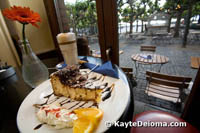 If you’re in the Altstadt ( Old Town), a nice place for an afternoon break isCafé Schwan, right on the square across from the old Schlossturm ( Castle Tower). If the weather is nice, there’s plenty of outdoor seating, but there’s lots of room inside too. The cake selection may not be very large, but you can pretty much depend on finding a great piece of cheesecake. Proprietor Kerstin Schwan, who also owns several other Dusseldorf restaurants, offers a full menu of German and international cuisine at the cafe. It’s especially popular for breakfast or brunch. Mühlenstraße 2 on the Burgplatz
If you’re in the Altstadt ( Old Town), a nice place for an afternoon break isCafé Schwan, right on the square across from the old Schlossturm ( Castle Tower). If the weather is nice, there’s plenty of outdoor seating, but there’s lots of room inside too. The cake selection may not be very large, but you can pretty much depend on finding a great piece of cheesecake. Proprietor Kerstin Schwan, who also owns several other Dusseldorf restaurants, offers a full menu of German and international cuisine at the cafe. It’s especially popular for breakfast or brunch. Mühlenstraße 2 on the Burgplatz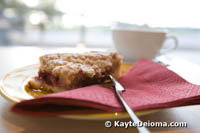 If your exploring
If your exploring 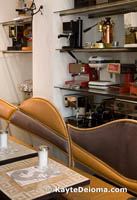
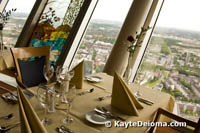 The rotating Top 180 (
The rotating Top 180 (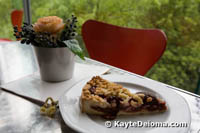 If you make the trip out to the
If you make the trip out to the 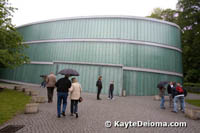 A couple quarrymen found the bones in a cave where they were mining limestone. After the most obvious human remains were removed, the digging continued and the site was buried under tons of gravel, its exact location forgotten. The Neanderthal bones made their way to the Rhine Province Museum in Bonn in 1877, but in 1937 a small Pre-History Museum was opened near the location of the original discovery. It went through various incarnations until a brand new building was opened in 1996 on a nearby site.
A couple quarrymen found the bones in a cave where they were mining limestone. After the most obvious human remains were removed, the digging continued and the site was buried under tons of gravel, its exact location forgotten. The Neanderthal bones made their way to the Rhine Province Museum in Bonn in 1877, but in 1937 a small Pre-History Museum was opened near the location of the original discovery. It went through various incarnations until a brand new building was opened in 1996 on a nearby site.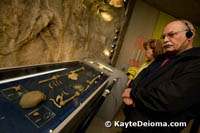 In 1997, archaeologists once again uncovered the original site. In 1997 and 2000 they recovered more bone fragments that matched the 1856 male skeleton, as well as additional remains of a woman and child. These original artifacts, along with replicas of the 1856 discoveries, are on display in the museum.
In 1997, archaeologists once again uncovered the original site. In 1997 and 2000 they recovered more bone fragments that matched the 1856 male skeleton, as well as additional remains of a woman and child. These original artifacts, along with replicas of the 1856 discoveries, are on display in the museum.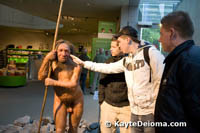 For its 10-year anniversary in 2006, the museum’s permanent exhibit was completely redone, using state-of-the-art technology to create the most accurate depictions yet of what Neanderthal man, woman and child most likely looked like and how they lived.
For its 10-year anniversary in 2006, the museum’s permanent exhibit was completely redone, using state-of-the-art technology to create the most accurate depictions yet of what Neanderthal man, woman and child most likely looked like and how they lived.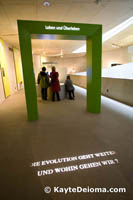 4 million years ago in Africa through today. You proceed from the lower level up a spiraling ramp through time. Themed exhibits includeLiving and Surviving, Tools and Knowledge, Myths and Religion, Nutrition and Environment, and Communication and Society.
4 million years ago in Africa through today. You proceed from the lower level up a spiraling ramp through time. Themed exhibits includeLiving and Surviving, Tools and Knowledge, Myths and Religion, Nutrition and Environment, and Communication and Society.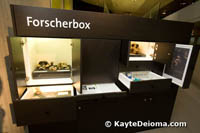 size models of Neanderthal men and women wouldn’t stand out too much in a crowd of modern-day humans.
size models of Neanderthal men and women wouldn’t stand out too much in a crowd of modern-day humans.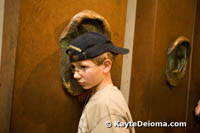 An audio exhibit of giant ears challenges the listener to imagine what cold or a cloud sounds like. To recreate the sensation of being in a grotto, you can stick your head up inside a cave-simulator suspended from the ceiling and look at cave
An audio exhibit of giant ears challenges the listener to imagine what cold or a cloud sounds like. To recreate the sensation of being in a grotto, you can stick your head up inside a cave-simulator suspended from the ceiling and look at cave 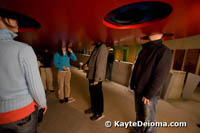 paintings projected on the walls. Kids will be tempted to climb up inside the cave-simulator, but don’t let them. The whole thing is hanging on a few screws and isn’t designed to hold weight.
paintings projected on the walls. Kids will be tempted to climb up inside the cave-simulator, but don’t let them. The whole thing is hanging on a few screws and isn’t designed to hold weight.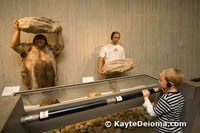 fur-clad ancestor with an Adidas-adorned 21st century German illustrates the relative strength of the two.
fur-clad ancestor with an Adidas-adorned 21st century German illustrates the relative strength of the two.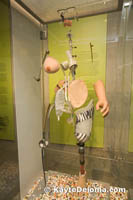 On the upper level is an interesting technology timeline. It shows the progression of technology from a fire flint to a Bic lighter; from a basic bore to a power drill, from a primitive needle and thread to a sewing machine. You can also see the present and future of human evolution with prosthetic limbs and other mechanical replacement parts for the body in use today.
On the upper level is an interesting technology timeline. It shows the progression of technology from a fire flint to a Bic lighter; from a basic bore to a power drill, from a primitive needle and thread to a sewing machine. You can also see the present and future of human evolution with prosthetic limbs and other mechanical replacement parts for the body in use today.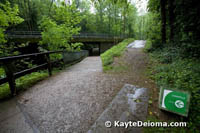 poncho and umbrella, like I did, you can visit the outdoor exhibits. In 2002, three trails were officially added to the museum presentation. The first, marked by green cubes, is theDiscovery Site. It is the shortest trail, just under a quarter mile from the museum. It is the only one on the same side of the street, heading to the right out the front door. The paved trail takes you along the Duessel River to the spot where the bones were found in 1856 and again in 1997 and 2000.
poncho and umbrella, like I did, you can visit the outdoor exhibits. In 2002, three trails were officially added to the museum presentation. The first, marked by green cubes, is theDiscovery Site. It is the shortest trail, just under a quarter mile from the museum. It is the only one on the same side of the street, heading to the right out the front door. The paved trail takes you along the Duessel River to the spot where the bones were found in 1856 and again in 1997 and 2000.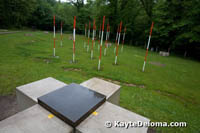 The cave has long since been reduced to quarry dust, and the site on the bank of the river has been replanted with grass and trees, although quarry work continues just over the hill. The Discovery Site (Fundstelle) is marked with red poles and surrounded by concrete crosses with text panels in the middle and plugs for your audio guide. I didn’t realize the audio trail continued outdoors, so I had already turned mine in, but I don’t think I would have wanted to plug in to a wet outlet anyway. The Discovery Site is a limited access area included with museum admission.
The cave has long since been reduced to quarry dust, and the site on the bank of the river has been replanted with grass and trees, although quarry work continues just over the hill. The Discovery Site (Fundstelle) is marked with red poles and surrounded by concrete crosses with text panels in the middle and plugs for your audio guide. I didn’t realize the audio trail continued outdoors, so I had already turned mine in, but I don’t think I would have wanted to plug in to a wet outlet anyway. The Discovery Site is a limited access area included with museum admission.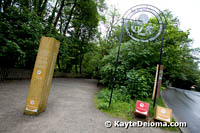 Across the street from the museum, two additional trails are marked out with red and yellow cubes. The yellow cubes mark the Menschenspuren (Human Traces) Trail, which leads to a series of sculptures on prehistoric themes by international artists. At the far end of this loop trail is the Game Reserve, with animals such as brumbies, wisents and aurochs that have been bred to be a close approximation of their ice age counterparts. It is recommended that you allow at least 90 minutes to complete the loop trail. The Human Traces Trail and Game Reserve are open access areas that do not require museum admission and are not restricted to museum hours.
Across the street from the museum, two additional trails are marked out with red and yellow cubes. The yellow cubes mark the Menschenspuren (Human Traces) Trail, which leads to a series of sculptures on prehistoric themes by international artists. At the far end of this loop trail is the Game Reserve, with animals such as brumbies, wisents and aurochs that have been bred to be a close approximation of their ice age counterparts. It is recommended that you allow at least 90 minutes to complete the loop trail. The Human Traces Trail and Game Reserve are open access areas that do not require museum admission and are not restricted to museum hours.